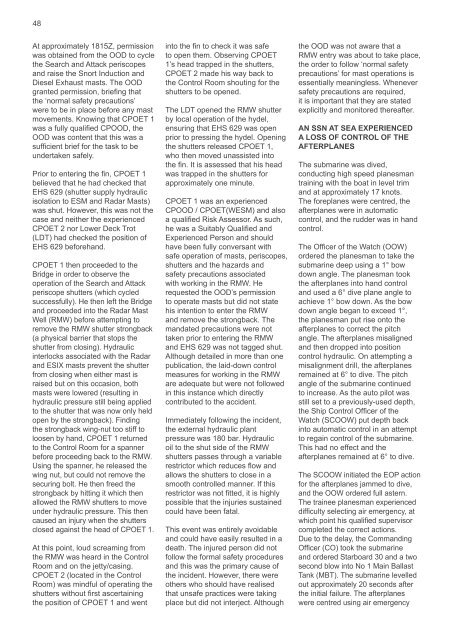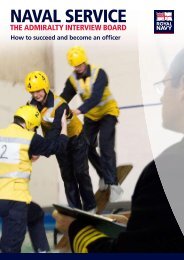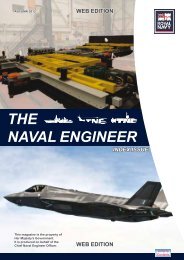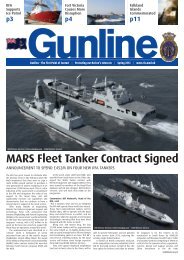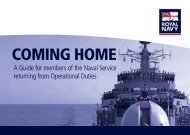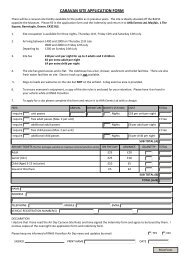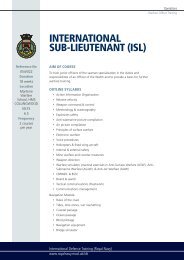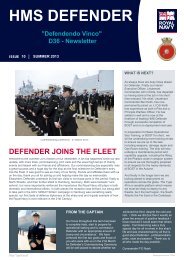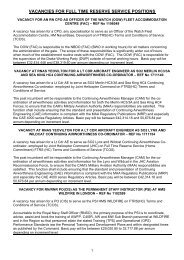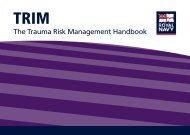THE NAVAL ENGINEER
THE NAVAL ENGINEER
THE NAVAL ENGINEER
Create successful ePaper yourself
Turn your PDF publications into a flip-book with our unique Google optimized e-Paper software.
48<br />
At approximately 1815Z, permission<br />
was obtained from the OOD to cycle<br />
the Search and Attack periscopes<br />
and raise the Snort Induction and<br />
Diesel Exhaust masts. The OOD<br />
granted permission, briefing that<br />
the ‘normal safety precautions’<br />
were to be in place before any mast<br />
movements. Knowing that CPOET 1<br />
was a fully qualified CPOOD, the<br />
OOD was content that this was a<br />
sufficient brief for the task to be<br />
undertaken safely.<br />
Prior to entering the fin, CPOET 1<br />
believed that he had checked that<br />
EHS 629 (shutter supply hydraulic<br />
isolation to ESM and Radar Masts)<br />
was shut. However, this was not the<br />
case and neither the experienced<br />
CPOET 2 nor Lower Deck Trot<br />
(LDT) had checked the position of<br />
EHS 629 beforehand.<br />
CPOET 1 then proceeded to the<br />
Bridge in order to observe the<br />
operation of the Search and Attack<br />
periscope shutters (which cycled<br />
successfully). He then left the Bridge<br />
and proceeded into the Radar Mast<br />
Well (RMW) before attempting to<br />
remove the RMW shutter strongback<br />
(a physical barrier that stops the<br />
shutter from closing). Hydraulic<br />
interlocks associated with the Radar<br />
and ESIX masts prevent the shutter<br />
from closing when either mast is<br />
raised but on this occasion, both<br />
masts were lowered (resulting in<br />
hydraulic pressure still being applied<br />
to the shutter that was now only held<br />
open by the strongback). Finding<br />
the strongback wing-nut too stiff to<br />
loosen by hand, CPOET 1 returned<br />
to the Control Room for a spanner<br />
before proceeding back to the RMW.<br />
Using the spanner, he released the<br />
wing nut, but could not remove the<br />
securing bolt. He then freed the<br />
strongback by hitting it which then<br />
allowed the RMW shutters to move<br />
under hydraulic pressure. This then<br />
caused an injury when the shutters<br />
closed against the head of CPOET 1.<br />
At this point, loud screaming from<br />
the RMW was heard in the Control<br />
Room and on the jetty/casing.<br />
CPOET 2 (located in the Control<br />
Room) was mindful of operating the<br />
shutters without first ascertaining<br />
the position of CPOET 1 and went<br />
into the fin to check it was safe<br />
to open them. Observing CPOET<br />
1’s head trapped in the shutters,<br />
CPOET 2 made his way back to<br />
the Control Room shouting for the<br />
shutters to be opened.<br />
The LDT opened the RMW shutter<br />
by local operation of the hydel,<br />
ensuring that EHS 629 was open<br />
prior to pressing the hydel. Opening<br />
the shutters released CPOET 1,<br />
who then moved unassisted into<br />
the fin. It is assessed that his head<br />
was trapped in the shutters for<br />
approximately one minute.<br />
CPOET 1 was an experienced<br />
CPOOD / CPOET(WESM) and also<br />
a qualified Risk Assessor. As such,<br />
he was a Suitably Qualified and<br />
Experienced Person and should<br />
have been fully conversant with<br />
safe operation of masts, periscopes,<br />
shutters and the hazards and<br />
safety precautions associated<br />
with working in the RMW. He<br />
requested the OOD’s permission<br />
to operate masts but did not state<br />
his intention to enter the RMW<br />
and remove the strongback. The<br />
mandated precautions were not<br />
taken prior to entering the RMW<br />
and EHS 629 was not tagged shut.<br />
Although detailed in more than one<br />
publication, the laid-down control<br />
measures for working in the RMW<br />
are adequate but were not followed<br />
in this instance which directly<br />
contributed to the accident.<br />
Immediately following the incident,<br />
the external hydraulic plant<br />
pressure was 180 bar. Hydraulic<br />
oil to the shut side of the RMW<br />
shutters passes through a variable<br />
restrictor which reduces flow and<br />
allows the shutters to close in a<br />
smooth controlled manner. If this<br />
restrictor was not fitted, it is highly<br />
possible that the injuries sustained<br />
could have been fatal.<br />
This event was entirely avoidable<br />
and could have easily resulted in a<br />
death. The injured person did not<br />
follow the formal safety procedures<br />
and this was the primary cause of<br />
the incident. However, there were<br />
others who should have realised<br />
that unsafe practices were taking<br />
place but did not interject. Although<br />
the OOD was not aware that a<br />
RMW entry was about to take place,<br />
the order to follow ‘normal safety<br />
precautions’ for mast operations is<br />
essentially meaningless. Whenever<br />
safety precautions are required,<br />
it is important that they are stated<br />
explicitly and monitored thereafter.<br />
An SSN at sea experienced<br />
a loss of control of the<br />
afterplanes<br />
The submarine was dived,<br />
conducting high speed planesman<br />
training with the boat in level trim<br />
and at approximately 17 knots.<br />
The foreplanes were centred, the<br />
afterplanes were in automatic<br />
control, and the rudder was in hand<br />
control.<br />
The Officer of the Watch (OOW)<br />
ordered the planesman to take the<br />
submarine deep using a 1° bow<br />
down angle. The planesman took<br />
the afterplanes into hand control<br />
and used a 6° dive plane angle to<br />
achieve 1° bow down. As the bow<br />
down angle began to exceed 1°,<br />
the planesman put rise onto the<br />
afterplanes to correct the pitch<br />
angle. The afterplanes misaligned<br />
and then dropped into position<br />
control hydraulic. On attempting a<br />
misalignment drill, the afterplanes<br />
remained at 6° to dive. The pitch<br />
angle of the submarine continued<br />
to increase. As the auto pilot was<br />
still set to a previously-used depth,<br />
the Ship Control Officer of the<br />
Watch (SCOOW) put depth back<br />
into automatic control in an attempt<br />
to regain control of the submarine.<br />
This had no effect and the<br />
afterplanes remained at 6° to dive.<br />
The SCOOW initiated the EOP action<br />
for the afterplanes jammed to dive,<br />
and the OOW ordered full astern.<br />
The trainee planesman experienced<br />
difficulty selecting air emergency, at<br />
which point his qualified supervisor<br />
completed the correct actions.<br />
Due to the delay, the Commanding<br />
Officer (CO) took the submarine<br />
and ordered Starboard 30 and a two<br />
second blow into No 1 Main Ballast<br />
Tank (MBT). The submarine levelled<br />
out approximately 20 seconds after<br />
the initial failure. The afterplanes<br />
were centred using air emergency


